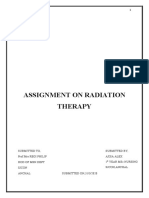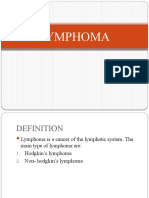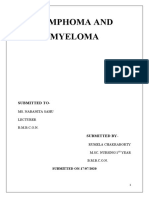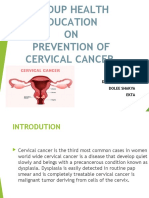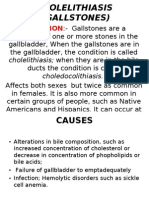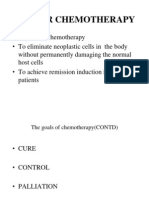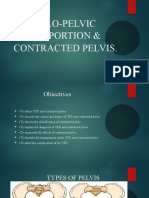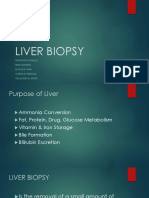Chemotherapy
The word chemotherapy means the use of any drug (such as aspirin or penicillin) to treat any disease, but
to most people chemotherapy refers to drugs used for cancer treatment.
Its often shortened to chemo. Two other medical terms used to describe cancer chemotherapy are
antineoplastic (meaning anti-cancer) therapy and cytotoxic (cell killing) therapy.
Treatments like radiation and surgery are considered local treatments. They act only in one area of the
body such as the breast, lung, or prostate and usually target the cancer directly. Chemotherapy differs
from surgery or radiation in that its almost always used as a systemic treatment. This means the drugs
travel throughout the body to reach cancer cells wherever they are.
Chemotherapy is used to treat many cancers. More than 100 chemotherapy drugs are used today either
alone or in combination with other drugs or treatments. As research continues, more drugs are expected to
become available. These drugs vary widely in their chemical composition, how they are taken, their
usefulness in treating specific forms of cancer, and their side effects.
New drugs are first developed through research in test tubes and animals. Then the drugs are tested in
clinical trials in humans to find out how safe they are and how well they work.
How chemotherapy works
To understand how chemotherapy works, it helps to understand the normal life cycle of a cell, or the cell
cycle. All living tissue is made up of cells. Cells grow and reproduce to replace cells lost through injury or
normal wear and tear. The cell cycle is a series of steps that both normal cells and cancer cells go
through in order to form new cells.
This discussion is somewhat technical, but it can help you understand how doctors predict which drugs
are likely to work well together and how doctors decide how often doses of each drug should be given.
The cell cycle has 5 phases which are labeled below using letters and numbers. Since cell reproduction
happens over and over, the cell cycle is shown as a circle. All the steps lead back to the resting phase
(G0), which is the starting point.
After a cell reproduces, the 2 new cells are identical. Each of the 2 cells made from the first cell can go
through this cell cycle again when new cells are needed.
The Cell Cycle
G0 phase (resting stage): The cell has not yet started to divide. Cells spend much of their lives in this
phase. Depending on the type of cell, G0 can last from a few hours to a few years. When the cell gets a
signal to reproduce, it moves into the G1 phase.
G1 phase: During this phase, the cell starts making more proteins and growing larger, so the new cells
will be of normal size. This phase lasts about 18 to 30 hours.
S phase: In the S phase, the chromosomes containing the genetic code (DNA) are copied so that both of
the new cells formed will have matching strands of DNA. The S phase lasts about 18 to 20 hours.
G2 phase: In the G2 phase, the cell checks the DNA and gets ready to start splitting into 2 cells. This
phase lasts from 2 to 10 hours.
M phase (mitosis): In this phase, which lasts only 30 to 60 minutes, the cell actually splits into 2 new
cells.
The cell cycle is important because many chemotherapy drugs work only on cells that are actively
reproducing (not cells that are in the resting phase, G0). Some drugs specifically attack cells in a
particular phase of the cell cycle (the M or S phases, for example).
Understanding how these drugs work helps oncologists predict which drugs are likely to work well
together. Doctors can also plan how often doses of each drug should be given based on the timing of the
cell phases.
Chemotherapy drugs cannot tell the difference between reproducing cells of normal tissues (those that are
replacing worn-out normal cells) and cancer cells. This means normal cells are damaged and this results
in side effects. Each time chemotherapy is given, it involves trying to find a balance between destroying
BSc. MCB
Year II
Lecturer: Shem Peter Mutua Mutuiri.
Main Campus
SBC 272: Biochemistry of Tumours
smutuiri@gmail.com
K.U.-
�the cancer cells (in order to cure or control the disease) and sparing the normal cells (to lessen unwanted
side effects).
GOALS OF CHEMOTHERAPY:
There are 3 possible goals for chemotherapy treatment:
1. Cure:
If possible, chemotherapy is used to cure the cancer, meaning that the cancer disappears and does not
return. However, most doctors do not use the word cure except as a possibility or intention. When
giving treatment that has a chance of curing a persons cancer, the doctor may describe it as treatment
with curative intent. But there are no guarantees, and though cure may be the goal, it doesnt always work
out that way. It often takes many years to know if a persons cancer is actually cured.
2. Control:
If cure is not possible, the goal may be to control the disease to shrink any cancerous tumors and/or
stop the cancer from growing and spreading. This can help someone with cancer feel better and possibly
live longer. In many cases, the cancer does not completely go away but is controlled and managed as a
chronic disease, much like heart disease or diabetes. In other cases, the cancer may even seem to have
gone away for a while, but its expected to come back.
3. Palliation:
When the cancer is at an advanced stage, chemotherapy drugs may be used to relieve symptoms caused
by the cancer. When the only goal of a certain treatment is to improve the quality of life but not treat the
disease itself, its called palliative treatment or palliation.
Sometimes, chemotherapy is the only treatment used. In other cases, chemotherapy may be given along
with other treatments. It may be used as adjuvant therapy or neoadjuvant therapy.
Adjuvant chemotherapy: After surgery to remove the cancer, there may still be some cancer cells left
behind that cannot be seen. When drugs are used to kill those unseen cancer cells, its called adjuvant
chemotherapy. Adjuvant treatment can also be given after radiation. An example of this would be
adjuvant hormone therapy after radiation for prostate cancer.
Neoadjuvant chemotherapy: Chemotherapy can be given before the main cancer treatment (such as
surgery or radiation). Giving chemotherapy first can shrink a large cancerous tumor, making it easier to
remove with surgery. Shrinking the tumor may also allow it to be treated more easily with radiation.
Neoadjuvant chemotherapy also can kill small deposits of cancer cells that cannot be seen on scans or xays.
DIFFERENT TYPES OF CHEMOTHERAPY DRUGS:
Chemotherapy drugs can be divided into several groups based on factors such as how they work, their
chemical structure, and their relationship to another drug. Because some drugs act in more than one way,
they may belong to more than one group.
Knowing how the drug works is important in predicting side effects. This helps oncologists decide which
drugs are likely to work well together. If more than one drug will be used, this information also helps
them plan exactly when each of the drugs should be given (in which order and how often).
1. Alkylating agents
Alkylating agents directly damage DNA to prevent the cancer cell from reproducing. As a class of drugs,
these agents are not phase-specific; in other words, they work in all phases of the cell cycle. Alkylating
agents are used to treat many different cancers, including leukemia, lymphoma, Hodgkin disease, multiple
myeloma, and sarcoma, as well as cancers of the lung, breast, and ovary.
Because these drugs damage DNA, they can cause long-term damage to the bone marrow. In rare cases,
this can eventually lead to acute leukemia. The risk of leukemia from alkylating agents is dosedependent, meaning that the risk is small with lower doses, but goes up as the total amount of the drug
BSc. MCB
Year II
Lecturer: Shem Peter Mutua Mutuiri.
Main Campus
SBC 272: Biochemistry of Tumours
smutuiri@gmail.com
K.U.-
�used gets higher. The risk of leukemia after getting alkylating agents is highest about 5 to 10 years after
treatment.
There are different classes of alkylating agents, including:
-Nitrogen mustards: such as mechlorethamine (nitrogen mustard), chlorambucil, cyclophosphamide
(Cytoxan), ifosfamide, and melphalan
Nitrosoureas: which include streptozocin, carmustine (BCNU), and lomustine
Alkyl sulfonates: busulfan
Triazines: dacarbazine (DTIC) and temozolomide (Temodar)
Ethylenimines: thiotepa and altretamine (hexamethylmelamine)
2. The platinum drugs (cisplatin, carboplatin, and oxalaplatin)
They are sometimes grouped with alkylating agents because they kill cells in a similar way. These drugs
are less likely than the alkylating agents to cause leukemia later on.
3. Antimetabolites
Antimetabolites are a class of drugs that interfere with DNA and RNA growth by substituting for the
normal building blocks of RNA and DNA. These agents damage cells during the S phase. They are
commonly used to treat leukemias, cancers of the breast, ovary, and the intestinal tract, as well as other
types of cancer.
Examples of antimetabolites include:
5-fluorouracil (5-FU)
6-mercaptopurine (6-MP)
Capecitabine (Xeloda)
Cladribine
Clofarabine
Cytarabine (Ara-C)
Floxuridine
Fludarabine
Gemcitabine (Gemzar)
Hydroxyurea
Methotrexate
Pemetrexed (Alimta)
Pentostatin
Thioguanine
4. Anti-tumor antibiotics/Anthracyclines:
Anthracyclines are anti-tumor antibiotics that interfere with enzymes involved in DNA replication. These
drugs work in all phases of the cell cycle. They are widely used for a variety of cancers. A major
consideration when giving these drugs is that they can permanently damage the heart if given in high
doses. For this reason, lifetime dose limits are often placed on these drugs. Examples of anthracyclines
include:
Daunorubicin
Doxorubicin (Adriamycin)
Epirubicin
Idarubicin
Other anti-tumor antibiotics
Anti-tumor antibiotics that are not anthracyclines include:
Actinomycin-D
Bleomycin
Mitomycin-C
BSc. MCB
Year II
Lecturer: Shem Peter Mutua Mutuiri.
Main Campus
SBC 272: Biochemistry of Tumours
smutuiri@gmail.com
K.U.-
�Mitoxantrone is an anti-tumor antibiotic that is similar to doxorubicin in many ways, including the
potential for damaging the heart. This drug also acts as a topoisomerase II inhibitor (see below), and can
lead to treatment-related leukemia. Mitoxantrone is used to treat prostate cancer, breast cancer,
lymphoma, and leukemia.
5. Topoisomerase inhibitors
These drugs interfere with enzymes called topoisomerases, which help separate the strands of DNA so
they can be copied. They are used to treat certain leukemias, as well as lung, ovarian, gastrointestinal, and
other cancers.
Examples of topoisomerase I inhibitors include; topotecan and irinotecan (CPT-11).
Examples of topoisomerase II inhibitors include etoposide (VP-16) and teniposide.
Mitoxantrone also inhibits topoisomerase II.
Treatment with topoisomerase II inhibitors increases the risk of a second cancer acute myelogenous
leukemia (AML). With this type of drug, a secondary leukemia can be seen as early as 2 to 3 years after
the drug is given.
6. Mitotic inhibitors
Mitotic inhibitors are often plant alkaloids and other compounds derived from natural products. They can
stop mitosis or inhibit enzymes from making proteins needed for cell reproduction.
These drugs work during the M phase of the cell cycle but can damage cells in all phases. They are used
to treat many different types of cancer including breast, lung, myelomas, lymphomas, and leukemias.
These drugs are known for their potential to cause peripheral nerve damage, which can be a dose-limiting
side effect.
Examples of mitotic inhibitors include:
Taxanes: paclitaxel (Taxol) and docetaxel (Taxotere)
Epothilones: ixabepilone (Ixempra)
Vinca alkaloids: vinblastine (Velban), vincristine (Oncovin), and vinorelbine
(Navelbine)
Estramustine (Emcyt)
7. Corticosteroids
Steroids are natural hormones and hormone-like drugs that are useful in treating some types of cancer
(lymphoma, leukemias, and multiple myeloma), as well as other illnesses. When these drugs are used to
kill cancer cells or slow their growth, they are considered chemotherapy drugs.
Corticosteroids are also commonly used as anti-emetics to help prevent nausea and vomiting caused by
chemotherapy. They are used before chemotherapy to help prevent severe allergic reactions
(hypersensitivity reactions), too. When a corticosteroid is used to prevent vomiting or allergic reactions,
its not considered chemotherapy.
Examples include prednisone, methylprednisolone (Solumedrol), and dexamethasone
(Decadron).
8. Miscellaneous chemotherapy drugs
Some chemotherapy drugs act in slightly different ways and do not fit well into any of the other
categories. Examples include drugs like L-asparaginase, which is an enzyme, and the proteosome
inhibitor bortezomib (Velcade).
OTHER TYPES OF CANCER DRUGS:
Other drugs and biological treatments are used to treat cancer, but are not usually considered
chemotherapy. While chemotherapy drugs take advantage of the fact that cancer cells divide rapidly, these
other drugs target different properties that set cancer cells apart from normal cells. They often have less
serious side effects than those commonly caused by chemotherapy drugs because they are targeted to
work mainly on cancer cells, not normal, healthy cells. Many are used along with chemotherapy.
1. Targeted therapies
BSc. MCB
Year II
Lecturer: Shem Peter Mutua Mutuiri.
Main Campus
SBC 272: Biochemistry of Tumours
smutuiri@gmail.com
K.U.-
�As researchers have learned more about the inner workings of cancer cells, they have begun to create new
drugs that attack cancer cells more specifically than traditional chemotherapy drugs. Most attack cells
with mutant versions of certain genes, or cells that express too many copies of a particular gene. These
drugs can be used as part of the main treatment, or they may be used after treatment to maintain remission
or decrease the chance of recurrence.
Examples of targeted therapies include imatinib (Gleevec), gefitinib (Iressa), sunitinib (Sutent) and
bortezomib (Velcade). Targeted therapies are a huge research focus and probably many more will be
developed in the future.
2. Differentiating agents
These drugs act on the cancer cells to make them mature into normal cells. Examples include the
retinoids, tretinoin (ATRA or Atralin) and bexarotene (Targretin), as well as arsenic trioxide
(Arsenox).
3. Hormone therapy
Drugs in this category are sex hormones, or hormone-like drugs, that change the action or production of
female or male hormones. They are used to slow the growth of breast, prostate, and endometrial (uterine)
cancers, which normally grow in response to natural hormones in the body. These cancer treatment
hormones do not work in the same ways as standard chemotherapy drugs, but rather by preventing the
cancer cell from using the hormone it needs to grow, or by preventing the body from making the
hormones.
Examples include:
The anti-estrogens: fulvestrant (Faslodex), tamoxifen, and toremifene (Fareston)
Aromatase inhibitors: anastrozole (Arimidex), exemestane (Aromasin), and letrozole (Femara)
Progestins:megestrol acetate (Megace)
Estrogens
Anti-androgens: bicalutamide (Casodex), flutamide (Eulexin), and nilutamide (Nilandron)
Gonadotropin-releasing hormone (GnRH), also known as luteinizing hormone releasing hormone
(LHRH) agonists or analogs: leuprolide (Lupron) and goserelin (Zoladex)
4. Immunotherapy
Some drugs are given to people with cancer to stimulate their natural immune systems to recognize and
attack cancer cells. These drugs offer a unique method of treatment, and are often considered to be
separate from chemotherapy. Compared with other forms of cancer treatment such as surgery, radiation
therapy, or chemotherapy, immunotherapy is still fairly new.
There are different types of immunotherapy. Active immunotherapies stimulate the bodys own immune
system to fight the disease. Passive immunotherapies do not rely on the body to attack the disease;
instead, they use immune system components (such as antibodies) created outside the body.
Types of immunotherapies and some examples include:
Monoclonal antibody therapy (passive immunotherapies), such as rituximab (Rituxan) and
alemtuzumab (Campath)
Non-specific immunotherapies and adjuvants (other substances or cells that boost the immune response),
such as BCG, interleukin-2 (IL-2), and interferon-alfa
Immunomodulating drugs, for instance, thalidomide and lenalidomide (Revlimid)
Cancer vaccines (active specific immunotherapies). In 2010, the FDA approved the first vaccine to treat
cancer (the Provenge vaccine for advanced prostate cancer); other vaccines for many different types of
cancer are being studied.
BSc. MCB
Year II
Lecturer: Shem Peter Mutua Mutuiri.
Main Campus
SBC 272: Biochemistry of Tumours
smutuiri@gmail.com
K.U.-
�REGIONAL CHEMOTHERAPY:
When theres a need to get high doses of chemotherapy to a specific area of the body, it may be given by a
regional method. Regional chemotherapy directs the anti-cancer drugs into the part of the body where the
cancer is. The purpose is to get more of the drug to the cancer, while trying to minimize side effects on
the whole body. Side effects will often still happen because the drugs can be partly absorbed into the
bloodstream and travel throughout the body. Examples of regional chemotherapy include drugs given into
these parts of the body:
Intra-arterial injected into an artery that goes to a certain area of the body
Intravesical infused into the bladder
Intrapleural infused into the chest cavity between the lung and chest wall
Intraperitoneal infused into the abdomen around the intestines and other organs
Intrathecal infused into the central nervous system via spinal fluid
Intralesional/intratumoral injected directly into the tumor
Topical applied to the skin as a cream or lotion
SAFETY PRECAUTIONS:
For health professionals:
Many chemotherapy drugs are considered hazardous to healthy people. Thats why the nurses and doctors
who give chemotherapy will take precautions to avoid direct contact with the drugs while giving them to
you.
Chemotherapy drugs can be dangerous to others in these ways:
They can cause abnormal changes in DNA. (They are mutagenic.)
They may be able to alter development of a fetus or embryo, leading to birth defects.
(They are teratogenic.)
They may be able to cause another type of cancer. (They are carcinogenic.)
Some may cause skin irritation or damage.
Nurses may wear special gloves, goggles, and gowns when preparing and giving you chemotherapy.
Pharmacists or nurses prepare the drugs in areas with special ventilation systems to avoid spattering
and/or inhaling the droplets that can form while mixing.
If youre in the hospital, the health care professionals caring for you may use special precautions when
they handle your urine and stool for a few days after treatment. This is because your body waste may
contain the drugs. If you get chemotherapy at home, you will be given special instructions and
precautions to ensure the safety of your caregivers and those living with you.
Special procedures are used to dispose of materials that were used to mix and give the drugs. There are
separate plastic containers to dispose of sharp items, syringes, IV tubing, and medicine bags. Gowns and
gloves are disposed of in special bags. If there are any visible leaks or spills, special precautions are used
to clean up the drugs.
For patients and their loved ones
There are many things you can do during and after chemotherapy to keep yourself and your loved ones
from being affected by the drugs while your body is getting rid of them.
It takes about 48 hours for your body to break down and/or get rid of most chemo drugs.
Most of this comes out in your body fluids urine, stool, tears, saliva, and vomit. The drugs are also
found in your blood. When these drugs leave your body as waste, they can harm or irritate skin even
other peoples skin. Keep in mind that for this reason, toilets can be a hazard for children and pets and its
important to be careful. Talk to your doctor about these and any other precautions you should follow.
During and for 48 hours after you finish getting chemotherapy:
Flush the toilet twice after you use it. Put the lid down before flushing to avoid splashing. If possible,
you might want to use a separate toilet during this time.
Both men and women should sit on the toilet to use it. This cuts down on splashing.
BSc. MCB
Year II
Lecturer: Shem Peter Mutua Mutuiri.
Main Campus
SBC 272: Biochemistry of Tumours
smutuiri@gmail.com
K.U.-
� Always wash your hands with warm water and soap after using the toilet. Use paper towels to dry your
hands.
If you vomit into the toilet, clean off all splashes and flush twice. If you vomit into a bucket or basin,
carefully empty it into the toilet without splashing the contents and flush twice. Wash out the bucket with
hot soapy water and rinse it, emptying the wash and rinse water into the toilet, then flushing it. Dry the
bucket with paper towels and throw them away.
Caregivers should wear throw-away waterproof gloves if they need to touch any of your body fluids.
(These can be bought in most drug stores.) They should always wash their hands with warm water and
soap afterward even if they wore gloves.
If a caregiver does come in contact with any of your body fluids they should wash the area very well
with warm soap and water. Although this isnt likely to cause any harm, try to take extra care to avoid
this. At your next visit, let your doctor know this happened. Being exposed frequently may lead to
problems.
Use a condom during sex and do so for about 2 weeks. The drugs can be found in semen and vaginal
secretions. (You may want to ask your doctor how long you should do this.)
Drugs might also be found in saliva, so avoid deep kissing and sharing food or drinks with others. Clean
flatware and dishes thoroughly with soap and warm water and rinse well before washing a second time
with the other dishes.
Any clothes or sheets that have body fluids on them should be washed in your washing machine not
by hand. Wash them twice in hot water with regular laundry detergent. Do not wash them with other
clothes. If they cannot be washed right away seal them in a plastic bag.
If using throw-away adult diapers, underwear, or sanitary pads, seal them in plastic and throw them
away with your regular trash.
Chemotherapy side effects
Although chemotherapy is given to kill cancer cells, it also damages normal cells. The
normal cells most likely to be damaged are those that divide rapidly, for instance:
Bone marrow/blood cells
Cells of hair follicles
Cells lining the digestive tract
Cells lining the reproductive tract
Damage to these cells accounts for many of the side effects of chemotherapy drugs. Side effects are
different for each chemotherapy drug. They also differ based on the dose, the way the drug is given, and
how the drug affects one individually.
NEW CLASSES OF CHEMOTHERAPY MEDICINES AND COMBINATIONS OF MEDICINES
ARE BEING DEVELOPED:
New ways to give the drugs are being studied, such as using smaller amounts over longer periods of time
or giving them continuously with special pumps.
Some newer medicines, called targeted therapies, are designed to attack a particular target on cancer
cells. These drugs may have fewer side effects than standard chemotherapy drugs and may be used along
with them. Several are now being studied, and many are already being used.
Other approaches to targeting drugs more specifically at the cancer cells such as attaching drugs to
monoclonal antibodies may make them work better and cause fewer side effects. Monoclonal
antibodies, which are special types of proteins made in the lab, can be designed to guide chemotherapy
drugs directly to the cancer cells. A number of these are being studied and some are available through
clinical trials. A couple of monoclonal antibodies that deliver radiation to the cancer cells have already
been approved.
BSc. MCB
Year II
Lecturer: Shem Peter Mutua Mutuiri.
Main Campus
SBC 272: Biochemistry of Tumours
smutuiri@gmail.com
K.U.-
� Monoclonal antibodies (without attached chemotherapy) can also be used as immunotherapy drugs, to
strengthen the bodys immune response against cancer cells.
A number of these types of drugs have been approved, and more are being studied.
For more on these drugs, see our document called Immunotherapy.
Liposomal therapy uses chemotherapy drugs that have been packaged inside liposomes (synthetic fat
globules). The liposome helps the drug penetrate the cancer cells more selectively and decreases possible
side effects (such as hair loss and nausea and vomiting). Examples of liposomal medicines already being
used are
Doxil (the encapsulated form of doxorubicin) and DaunoXome (the encapsulated form of
daunorubicin).
Chemoprotective agents are being developed to protect against specific side effects of certain
chemotherapy drugs. For example, dexrazoxane (Zinecard) helps prevent heart damage, amifostine
(Ethyol) helps protect the kidneys, and mesna protects the bladder.
Some new agents may be given along with chemotherapy to help overcome drug resistance. Cancer cells
often become resistant to chemotherapy by developing the ability to pump the drugs out of the cells.
These new agents inactivate the pumps, which allows the chemotherapy to remain in the cancer cells
longer, which might make it more effective.
References
Gullatte MM, Gaddis J. Chemotherapy. In: Varrichio CG, ed. A Cancer Source Book for
Nurses. 8th ed. Sudbury, Mass: Jones and Bartlett; 2004:103-130.
.
National Cancer Institute Accessed at
www.cancer.gov/cancertopics/ on September 8th, 2014.
BSc. MCB
Year II
Lecturer: Shem Peter Mutua Mutuiri.
Main Campus
SBC 272: Biochemistry of Tumours
smutuiri@gmail.com
K.U.-






